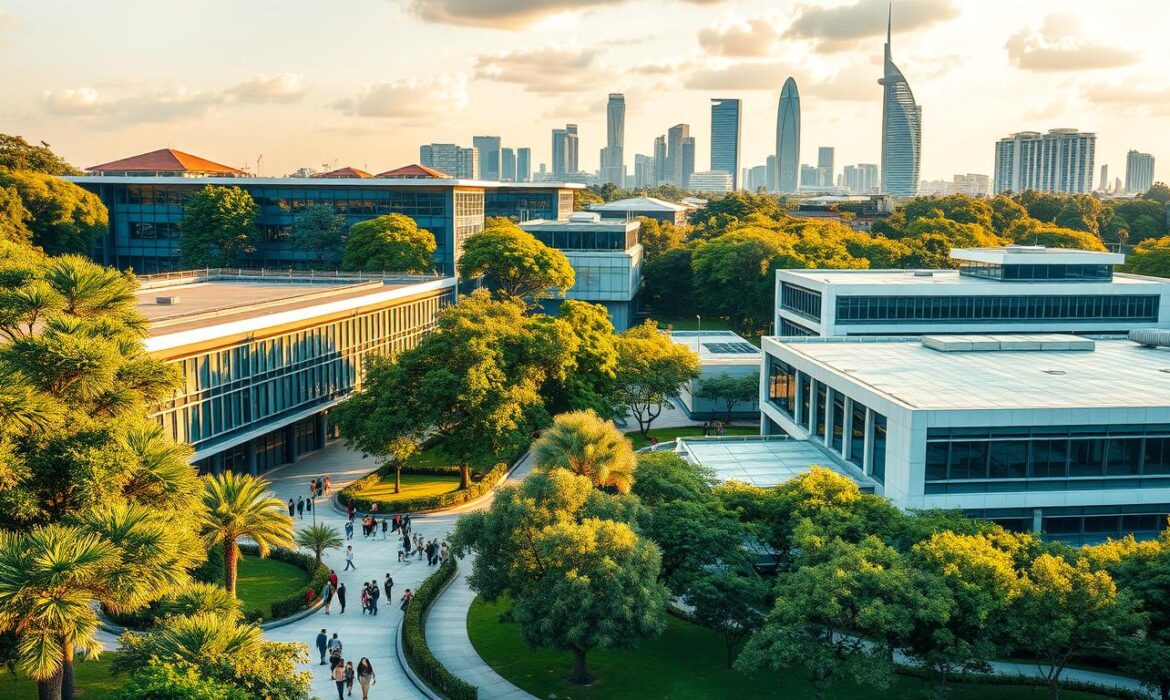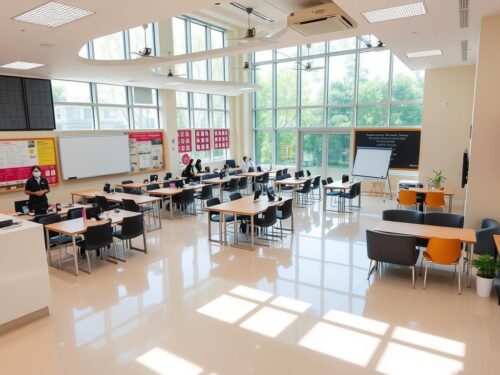Singapore’s education system is known for its excellence, and its polytechnics play a key role in shaping future professionals. These institutions offer practical, industry-focused programs that prepare students for the workforce. Choosing the right one can make a big difference in career success.
Five main institutions stand out: SP, NP, TP, NYP, and RP. Each offers unique strengths, from advanced facilities to strong graduate outcomes. Rankings often consider factors like academic quality, student support, and industry partnerships.
Polytechnic education is also a stepping stone to university admission. With annual tuition costs starting at $3,000, it’s a valuable investment in a diploma that holds weight in Singapore’s job market. For students, it’s a practical path to both immediate employment and further education.
Key Takeaways
- Singapore’s polytechnics provide industry-aligned education for career readiness.
- Five main institutions offer diverse programs and facilities.
- Rankings focus on academic quality, graduate outcomes, and student support.
- Diploma qualifications open doors to both jobs and university opportunities.
- Tuition costs are affordable compared to other educational paths.
Introduction to Polytechnics in Singapore
Polytechnics in Singapore are designed to bridge the gap between education and the workforce. These institutions focus on practical skills, preparing students for real-world challenges. With a strong emphasis on hands-on learning, they offer three-year programs that include internships and industry projects.
Students typically intern at top companies during their final year. This experience helps them gain valuable insights and skills. Graduates often enter industries directly related to their diplomas, ensuring a smooth transition into the workforce.
- They serve as tertiary institutions in the education ecosystem.
- Admission is based on post-O/N Level pathways with L1R4/L1R5 requirements.
- Hands-on learning is emphasized through industry projects.
- Mandatory internship programs include company assessments.
- Graduate employment rates are high, with 92% employed in 2023.
- Strong partnerships with companies like DBS, EY, and Resorts World.
- Pathways to local universities or direct workforce entry.
Enrollment statistics for 2025 show over 45,000 students in these institutions. This reflects their growing popularity and relevance in Singapore’s education landscape.
| Feature | Details |
|---|---|
| Program Length | 3 years |
| Internship | Mandatory in final year |
| Graduate Employment Rate | 92% (2023) |
| University Pathways | 17% admission rate |
Polytechnics are a practical choice for students seeking both immediate employment and further education opportunities. Their focus on real-world skills makes them a valuable part of Singapore’s education system.
What is a Polytechnic?
Polytechnics are government-funded institutions offering practical education. They focus on equipping students with industry-ready skills through a blend of classroom learning and hands-on training. These institutions are legally recognized and play a vital role in shaping career-ready professionals.
Programs typically span three years, with two semesters each year. Students undergo four major exams annually, ensuring a structured academic journey. The grading system differs from traditional schools, emphasizing continuous assessment and practical application.
Specialized facilities like engineering labs and design studios enhance the learning experience. Digital platforms are widely used, making education more accessible and interactive. For example, some institutions employ paperless systems and open-book exams to encourage critical thinking.
- Industry certifications are embedded in the curriculum, boosting employability.
- The student-teacher ratio averages 25:1, ensuring personalized attention.
- Continuing education options, such as PACE Academy, provide lifelong learning opportunities.
Polytechnics are more than just educational institutions. They are gateways to knowledge, practical skills, and career success. With their focus on real-world application, they prepare students to excel in their chosen fields.
Polytechnic vs. Junior College: Which is Right for You?
Choosing between a poly and a junior college can shape your future in different ways. Both paths offer unique benefits, but your decision should align with your career goals and learning preferences. Let’s explore the key factors to consider.
Financial Considerations
Cost is a major factor when deciding between a poly and a junior college. Junior colleges are more affordable, with annual fees around $200. In contrast, poly courses start at $3,000 per year. However, poly students can use CPF funds to offset tuition costs.
Hidden expenses also matter. Junior college students may spend more on transportation, while poly students often need specialized uniforms or equipment. Planning your budget is essential for a smooth educational journey.
Program Length and Focus
Junior colleges offer a two-year program focused on academic preparation for university. Students typically spend 35 hours weekly in classrooms. Poly courses, on the other hand, span three years and emphasize practical skills through hands-on training and internships.
If you prefer a structured academic environment, junior college might be the better choice. For those seeking industry-ready skills, poly provides a more practical approach. Both paths can lead to successful careers, but their focus differs significantly.
Stress and Time Management
Junior college students often face intense academic pressure, especially during exams. Poly students, however, enjoy a more balanced schedule with around 20 weekly classroom hours. This allows for self-directed learning and part-time work opportunities.
Mental health resources are available in both systems. Junior colleges offer counseling for exam stress, while poly institutions provide support for managing internships and projects. Choose the path that aligns with your stress tolerance and time management skills.
- Tuition costs: Junior college ($200/year) vs. poly ($3,000+).
- Program length: 2 years (junior college) vs. 3 years (poly).
- University pathways: 75% of junior college students enter university vs. 17% from poly.
- Weekly commitment: 35 hours (junior college) vs. 20 hours (poly).
- Graduate salaries: Comparable, with slight variations by industry.
For more insights on choosing the right path, check out this detailed comparison. Your decision will shape your education and career, so weigh the options carefully.
Top 5 Polytechnics in Singapore
Singapore’s top polytechnics are renowned for their innovative programs and industry connections. These institutions prepare students for the workforce with hands-on training and strong partnerships. Let’s explore the top five and what sets them apart.
Rankings are based on graduate employment rates, industry collaborations, and campus facilities. Each institution has unique strengths, from research output to international programs. Here’s a closer look at their key features.
- Singapore Polytechnic (SP): Established in 1954, it’s the oldest and has the largest campus at 38 hectares. Known for its engineering and business programs.
- Ngee Ann Polytechnic (NP): Ranked #1 in Webometrics, it excels in media and design courses. Notable alumni include industry leaders in tech and creative fields.
- Temasek Polytechnic (TP): Offers strong hospitality and tourism programs. Its campus features state-of-the-art training facilities.
- Nanyang Polytechnic (NYP): Focuses on health sciences and engineering. Known for its high research output and innovation indexes.
- Republic Polytechnic (RP): The newest, established in 2002, it has the smallest campus at 20 hectares. Emphasizes problem-based learning and international collaborations.
Enrollment statistics for 2025 show a growing interest in these institutions. SP leads with over 15,000 students, while RP has around 8,000. Each polytechnic offers unique pathways to success, whether through direct employment or further education.
| Institution | Established | Campus Size | Notable Alumni |
|---|---|---|---|
| Singapore Polytechnic | 1954 | 38 hectares | Engineering leaders |
| Ngee Ann Polytechnic | 1963 | 36 hectares | Tech innovators |
| Temasek Polytechnic | 1990 | 30 hectares | Hospitality experts |
| Nanyang Polytechnic | 1992 | 32 hectares | Health professionals |
| Republic Polytechnic | 2002 | 20 hectares | Business entrepreneurs |
These institutions are more than just educational hubs. They are gateways to career success, offering programs tailored to industry needs. Whether you’re drawn to engineering, media, or health sciences, there’s a polytechnic for you.
1. Singapore Polytechnic (SP)
Founded in 1954, Singapore Polytechnic (SP) has been a cornerstone of practical education in the region. As the oldest institution of its kind, it has built a reputation for excellence in preparing students for the workforce. With over 70 years of history, SP continues to innovate and lead in fields like engineering, maritime studies, and aerospace.
History and Reputation
SP’s legacy is rooted in its commitment to hands-on learning. It was the first to introduce diploma programs in Singapore, setting a standard for other institutions. Today, it boasts a strong alumni network, including industry leaders in sectors like technology and maritime.
Collaborations with global giants like Rolls-Royce and ST Engineering further enhance its reputation. These partnerships provide students with real-world exposure and cutting-edge training opportunities.
Courses Offered
SP offers 37 courses across 11 schools, catering to diverse interests. Its engineering programs, particularly in maritime and aerospace, are highly regarded. Other popular fields include business, design, and information technology.
Unique programs like the Singapore Maritime Academy ensure graduates are industry-ready. The curriculum is designed to blend theoretical knowledge with practical application, making SP a preferred choice for many.
Facilities and Campus Life
The campus is equipped with state-of-the-art facilities, including digital fabrication labs and maker spaces. Sports enthusiasts can enjoy an Olympic-sized pool, 12 badminton courts, and a rock-climbing wall.
Student life at SP is vibrant, with leadership programs and camps fostering personal growth. Its proximity to the one-north tech hub also provides ample opportunities for internships and networking.
“SP’s focus on innovation and industry partnerships ensures graduates are well-prepared for the future.”
With its rich history, diverse courses, and exceptional facilities, Singapore Polytechnic (SP) remains a top choice for aspiring professionals.
2. Ngee Ann Polytechnic (NP)
Ngee Ann Polytechnic (NP) stands out as a leader in creative and technical education, blending innovation with practical learning. Established in 1963, it has grown into one of the most respected institutions, known for its focus on film, media, and design. With 39 diverse courses, NP prepares students for dynamic careers in various industries.
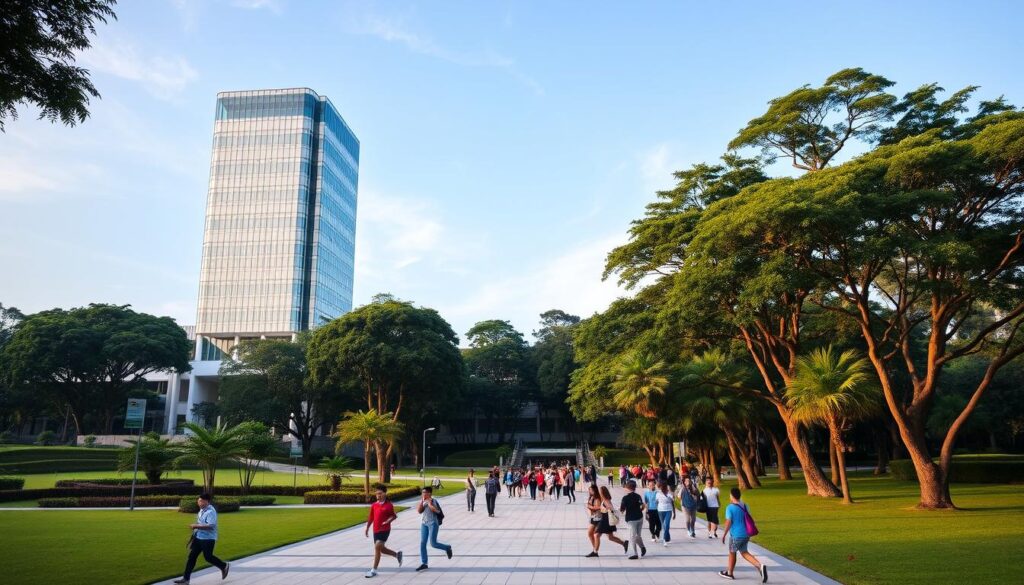
History and Reputation
Since its founding, NP has been a pioneer in education. It was the first to introduce film studies in the region, setting a benchmark for creative programs. Its Webometrics ranking as #1 reflects its commitment to excellence and innovation.
NP’s strong industry ties with companies like Mediacorp and Ubisoft provide students with real-world exposure. Collaborations with DBS Bank in FinTech labs further enhance its reputation as a forward-thinking institution.
Courses Offered
NP offers a wide range of courses, from business and accountancy to media and design. Its flagship School of Film & Media Studies is renowned for producing industry-ready professionals. Unique programs like the NP International Film Festival and cinema studies equipment rentals add value to the learning experience.
- Top-ranked for business and accountancy.
- Flagship School of Film & Media Studies.
- Mediapolis satellite campus facilities.
- Strong alumni network in creative industries.
Facilities and Campus Life
The campus is equipped with modern amenities, including an Olympic-sized pool, an adventure park, and a lifestyle library. These facilities support both academic and extracurricular activities, fostering a well-rounded student experience.
Student life at NP is vibrant, with opportunities for leadership and personal growth. Its proximity to Mediapolis provides access to cutting-edge resources and networking opportunities.
| Feature | Details |
|---|---|
| Established | 1963 |
| Courses | 39 |
| Notable Programs | Film, Media, Design |
| Facilities | Olympic pool, Adventure park, Lifestyle library |
With its rich history, diverse courses, and exceptional facilities, Ngee Ann Polytechnic continues to shape the future of creative and technical education.
3. Temasek Polytechnic (TP)
Temasek Polytechnic (TP) has been a hub of innovation and practical learning since its establishment in 1990. Located in the east, it is the only institution of its kind in the region, offering a unique blend of creativity and technical expertise. With 37 diverse courses, TP prepares students for dynamic careers in fields like law, design, and digital marketing.
History and Reputation
TP has built a strong reputation for its industry-aligned programs and cutting-edge facilities. It was the first to introduce specialized diplomas in areas like maritime law and UX design. Collaborations with global brands like Google and local industries ensure students gain real-world experience.
The institution’s Center for Transcultural Studies fosters global perspectives, while its annual TP Design Week showcases student creativity. These initiatives highlight TP’s commitment to excellence and innovation.
Courses Offered
TP offers a wide range of courses, from legal executive diplomas to fashion design. Its unique maritime law program is highly regarded, as are its digital marketing certifications in partnership with Google. Students also benefit from UX design labs equipped with industry-standard software.
- Legal executive diploma partnerships with top law firms.
- Fashion design program runway shows.
- TP-Google digital marketing certifications.
- UX design labs with advanced tools.
Facilities and Campus Life
TP’s campus features state-of-the-art facilities, including design incubators and a moot court. These resources provide hands-on learning opportunities, preparing students for real-world challenges. The proximity to Changi Business Park also offers networking and internship opportunities.
Student life is vibrant, with leadership programs and exhibitions like TP Design Week fostering personal growth. The campus environment encourages creativity and collaboration, making TP a preferred choice for many.
| Feature | Details |
|---|---|
| Established | 1990 |
| Courses | 37 |
| Specialties | Law, Design, Digital Marketing |
| Facilities | Design incubators, Moot court, UX labs |
With its focus on innovation and practical learning, Temasek Polytechnic continues to shape the future of education and career readiness.
4. Nanyang Polytechnic (NYP)
Nanyang Polytechnic (NYP) has been a leader in practical education since its founding in 1992. Known for its white campus and innovative programs, NYP focuses on preparing students for the demands of the modern workforce. Its emphasis on IT and industry collaboration makes it a standout institution.
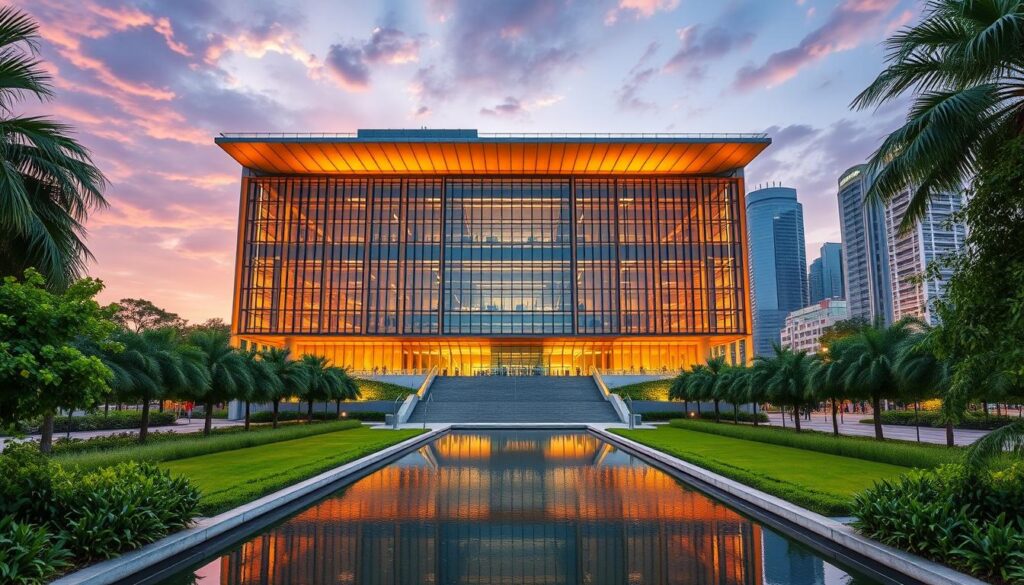
History and Reputation
Since its establishment, NYP has built a strong reputation for its focus on technology and innovation. It is recognized as a leader in IT and cybersecurity, with programs designed to meet industry needs. Collaborations with organizations like the Cyber Security Agency (CSA) and the Monetary Authority of Singapore (MAS) highlight its commitment to real-world relevance.
NYP’s NYP-Samsung Innovation Lab and Microsoft certifications embedded in the curriculum ensure students gain practical skills. The WhiteSpace entrepreneurship hub fosters creativity and innovation, making NYP a preferred choice for aspiring professionals.
Courses Offered
NYP offers 40 diverse courses, with a strong focus on IT, cybersecurity, and health sciences. Unique programs like cloud computing specializations and nursing simulation hospitals provide hands-on learning opportunities. Students also benefit from FinTech partnerships and cutting-edge resources.
- Strong focus on IT and cybersecurity.
- NYP-Samsung Innovation Lab for practical training.
- Microsoft certifications embedded in the curriculum.
- WhiteSpace entrepreneurship hub for innovation.
- Nursing simulation hospitals for health sciences.
Facilities and Campus Life
The campus is equipped with state-of-the-art facilities, including an Olympic-sized pool, rock walls, and an adventure park. These amenities support both academic and extracurricular activities, fostering a well-rounded student experience.
Student life at NYP is vibrant, with opportunities for leadership and personal growth. The campus environment encourages creativity and collaboration, making NYP a preferred choice for many.
| Feature | Details |
|---|---|
| Established | 1992 |
| Courses | 40 |
| Specialties | IT, Cybersecurity, Health Sciences |
| Facilities | Olympic pool, Rock walls, Adventure park |
With its focus on innovation and practical learning, Nanyang Polytechnic continues to shape the future of education and career readiness.
5. Republic Polytechnic (RP)
Republic Polytechnic (RP) stands out for its innovative approach to education, blending problem-solving with practical skills. Established in 2002, it has quickly become a leader in modern education methods. With a strong focus on sports and hands-on learning, RP offers a unique experience for students.
History and Reputation
Since its founding, RP has been a pioneer in Problem-Based Learning (PBL). This teaching method encourages students to solve real-world challenges, preparing them for dynamic careers. Collaborations with organizations like SportSG and the RP-AC Milan soccer academy highlight its commitment to excellence.
Courses Offered
RP offers 45 diverse courses, with a special emphasis on sports management and esports. Unique programs like outdoor education modules and digital learning platforms ensure students gain practical skills. The esports management program is particularly popular, reflecting the growing demand in this field.
- Problem-Based Learning (PBL) pedagogy.
- Sports management degree pathways.
- RP-AC Milan soccer academy partnership.
- Esports management program.
Facilities and Campus Life
The campus boasts state-of-the-art facilities, including a martial arts studio and an aerobics center. Olympic-level training resources are available for aspiring athletes. The fully air-conditioned campus ensures a comfortable learning environment.
Student life at RP is vibrant, with opportunities for leadership and personal growth. The emphasis on teamwork and innovation fosters a collaborative atmosphere, making RP a preferred choice for many.
What Makes a Polytechnic the Best?
When evaluating what sets a top institution apart, several key factors come into play. Graduate employment rates, industry partnerships, and campus facilities are among the most critical. These elements ensure that students receive a well-rounded education that prepares them for their future career.
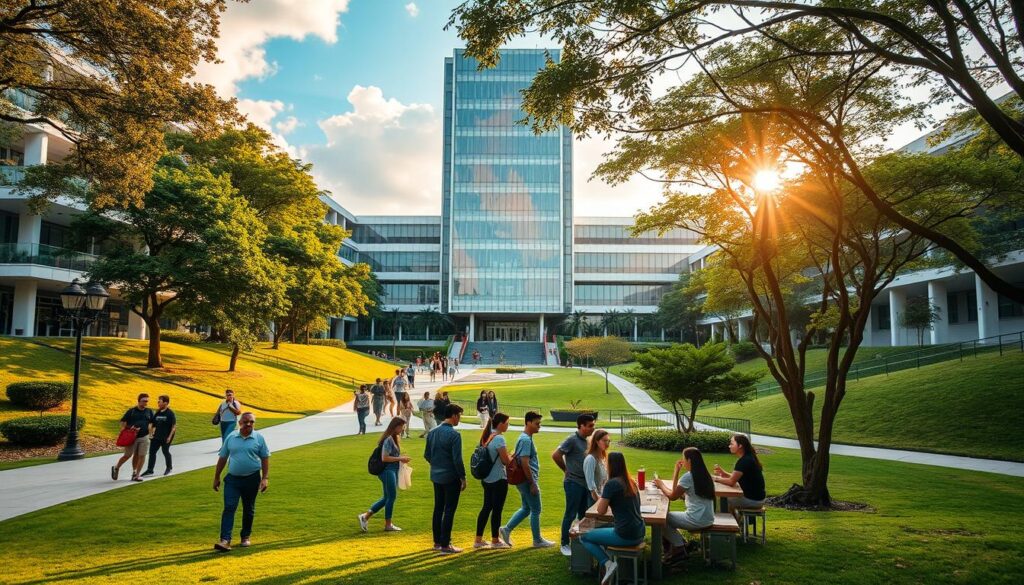
Graduate employment surveys for 2025 reveal that institutions with strong industry ties have higher placement rates. Industry advisory boards play a vital role in shaping courses to meet market demands. This ensures that graduates are equipped with relevant skills and knowledge.
Campus investments also matter. Modern facilities, such as labs and innovation hubs, enhance the learning experience. For example, some institutions offer state-of-the-art sports complexes and design studios, fostering both academic and extracurricular growth.
“A top institution not only educates but also empowers students to excel in their chosen fields.”
Other factors include research commercialization success rates and global exchange programs. These initiatives provide students with opportunities to gain international exposure and contribute to groundbreaking projects.
- High graduate employment rates reflect program relevance.
- Industry partnerships ensure real-world training opportunities.
- Modern campus facilities enhance learning and creativity.
- Global exchange programs broaden perspectives.
For more insights on what makes a best polytechnic in Singapore, check out this detailed comparison. Choosing the right institution can shape your career and future success.
Polytechnic Education: What to Expect
Polytechnic education offers a unique blend of academic rigor and practical training. It is designed to prepare students for the demands of the modern workforce. From classroom learning to hands-on projects, this approach ensures a well-rounded experience.
Academic Year and Structure
The academic year in polytechnics runs from April to April, divided into two semesters. Each semester includes a mix of classroom learning and practical assignments. The modular credit system allows students to progress at their own pace, ensuring flexibility and personalized learning.
- Continuous assessment replaces traditional year-end exams.
- Academic probation policies ensure students stay on track.
- Credit requirements vary by program, with options for electives.
Examinations and Grading
Polytechnics emphasize continuous assessment over traditional exams. Students undergo four major assessments each year, ensuring consistent progress. Republic Polytechnic (RP) uses open-book exams to encourage critical thinking and problem-solving skills.
| Assessment Type | Details |
|---|---|
| Continuous Assessment | Ongoing evaluations through projects and assignments. |
| Open-Book Exams | Focus on application rather than memorization. |
| Grading System | Combination of coursework and practical performance. |
Internship Opportunities
Internships are a cornerstone of polytechnic education. In the final year, students undertake a six-month internship, gaining real-world experience. These opportunities often lead to job offers or valuable industry connections.
- Overseas internships broaden global perspectives.
- Company projects provide hands-on experience.
- Industry mentorship programs guide career development.
Graduates leave with a strong portfolio, ready to excel in their chosen fields. Whether entering the workforce or pursuing further education, polytechnic graduates are well-prepared for success.
Life as a Polytechnic Student
Life as a polytechnic student is a dynamic mix of academics, extracurriculars, and personal growth. From orientation camps to leadership programs, the experience is designed to prepare students for both their careers and personal development.
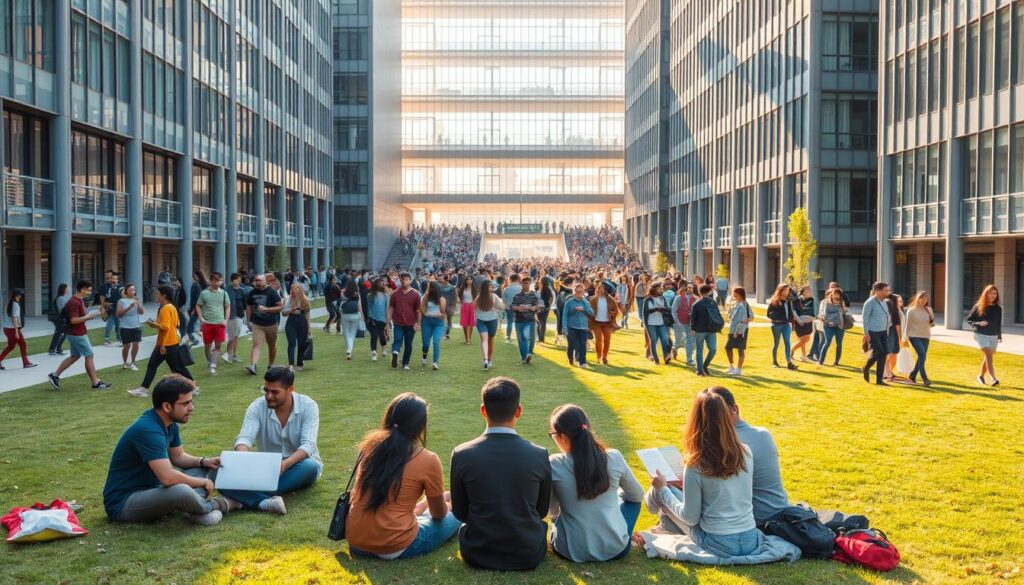
Orientation camps are a highlight, helping newcomers bond with peers and adapt to campus life. Co-curricular activities (CCAs) offer opportunities to explore interests, from sports to arts. With 92 free hours per week, students can balance studies with hobbies and part-time work.
Dress code freedom allows for self-expression, while transport concessions make commuting affordable. These perks enhance the overall experience, making polytechnic life both enjoyable and practical.
A typical weekday includes classroom sessions, group projects, and CCA meetings. For those needing accommodation, student housing options are available, fostering a sense of community. Inter-polytechnic competitions add excitement, encouraging teamwork and healthy rivalry.
Leadership development programs empower students to take initiative and grow as individuals. Mental health support services ensure well-being, while entrepreneurship initiatives inspire innovation. Cross-disciplinary projects provide hands-on learning, and alumni networking events open doors to future opportunities.
“Polytechnic life is more than just education—it’s a journey of growth, creativity, and connection.”
With modern facilities and a supportive environment, polytechnics offer a well-rounded experience. Whether through academics, CCAs, or leadership roles, students leave with skills and memories that last a lifetime. For more insights on campus life, check out this detailed guide.
Career Opportunities After Polytechnic
Graduating from a polytechnic opens doors to diverse career paths and professional growth. With a 92% employment rate within six months, graduates are well-prepared to enter the workforce. The average starting salary of $2,600 reflects the value of their practical training and industry-ready skills.
Top hiring industries include technology, healthcare, and engineering. These sectors actively seek polytechnic graduates for their hands-on experience and technical expertise. Additionally, many graduates secure roles in creative fields, business, and hospitality.
For those pursuing further education, direct entry into the second year of university is a common pathway. This allows students to build on their diploma qualifications and specialize in their chosen fields. Professional certification programs also provide additional options for skill enhancement.
- Graduate salary benchmarks: Competitive starting salaries across industries.
- University articulation agreements: Seamless transition to higher education.
- Professional certification pathways: Opportunities for continuous learning.
- Entrepreneurship success stories: Graduates launching their own ventures.
- Continuing education options: SkillsFuture credits for lifelong learning.
- Global work opportunities: International placements and collaborations.
Entrepreneurship is another exciting avenue for polytechnic graduates. Many leverage their skills to start businesses, supported by mentorship programs and incubators. Continuing education is also encouraged, with SkillsFuture credits helping students upskill and stay competitive.
| Feature | Details |
|---|---|
| Employment Rate | 92% within 6 months |
| Average Starting Salary | $2,600 |
| University Pathways | Direct entry to 2nd year |
| Top Hiring Industries | Technology, Healthcare, Engineering |
Global opportunities are also available, with graduates securing roles in international companies and projects. Whether entering the workforce or pursuing further education, polytechnic graduates have a wide range of options to shape their careers.
Fees and Financial Aid
Understanding the financial aspects of polytechnic education is crucial for students and their families. With annual fees starting at $3,000, planning ahead ensures a smooth educational journey. Fortunately, there are several financial aid options to ease the burden.
CPF payment options allow families to use their savings for tuition. Bursaries cover up to 75% of costs, making education accessible to all. Additionally, a $50 transport concession helps reduce commuting expenses.
Here’s a breakdown of key financial considerations:
- Detailed fee breakdown by course: Fees vary depending on the program, with engineering and IT courses often costing more.
- MOE subsidies eligibility criteria: Subsidies are available for Singaporean citizens and permanent residents.
- Scholarship application timelines: Apply early to secure merit-based or need-based scholarships.
- Study loans comparison: Compare interest rates and repayment terms to find the best fit.
- Part-time work opportunities: Many students balance studies with part-time jobs to cover expenses.
- Financial literacy programs: Workshops help students manage budgets and plan for the future.
- Hidden costs estimation: Factor in expenses like uniforms, equipment, and project materials.
- ROI analysis by diploma: Evaluate potential earnings to understand the long-term benefits of your chosen course.
By exploring these options, students can focus on their education without financial stress. Whether through scholarships, bursaries, or part-time work, there are plenty of ways to make polytechnic education affordable and rewarding.
How to Choose the Right Polytechnic for You
Deciding on the right institution for your education journey requires careful thought and research. Your choice will shape your learning experience and future career. Start by evaluating the courses offered and how they align with your interests and goals.
Location is another key factor. Consider the proximity to your home or workplace, as well as the accessibility of public transport. Campus culture also plays a significant role. Visit open houses to get a feel for the environment and interact with current students and faculty.
Here are some tips to guide your decision:
- Take a course matching personality test to identify programs that suit your strengths.
- Create a campus tour checklist to evaluate facilities and resources.
- Seek insights from alumni interviews to understand the real-world impact of the programs.
- Analyze industry trends to ensure your chosen field has strong growth potential.
- Explore graduate success stories to see how others have benefited from their education.
- Compare special needs support services if you require additional assistance.
- Consider international student programs if you’re from abroad.
- Look into environmental sustainability initiatives to align with your values.
Industry links are crucial for practical training and job opportunities. Institutions with strong partnerships often provide better internships and networking opportunities. Attend open houses to ask questions and gather firsthand information.
Your choice of institution will influence your academic and professional journey. Take the time to explore your options and make an informed decision. With the right choice, you’ll set yourself up for success in both your education and future career.
Conclusion
Making the right educational choice can shape your future career and personal growth. As you consider your options, remember to evaluate factors like program offerings, campus culture, and industry connections. These elements ensure a well-rounded experience that prepares you for success.
Future trends in education emphasize innovation and adaptability. Institutions are increasingly focusing on digital skills and global exposure. Staying informed about these developments can help you make a forward-thinking decision.
Before finalizing your choice, visit campuses to get a feel for the environment. Talk to current students and faculty to gain insights. Don’t forget to check application deadlines and gather all necessary documents.
For further guidance, reach out to admissions offices or explore tutoring support services. Your educational journey is a stepping stone to a fulfilling career. Take the time to make an informed decision that aligns with your goals.

